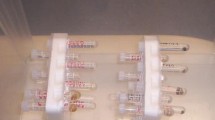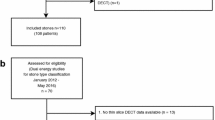Abstract
Accurate prediction of the response of an individual patient to lithotripsy remains impossible. Certain factors such as the chemical composition, size, and position of the calculus are known to be important in determining the success rate. This paper reports the use of magnetic resonance imaging (MRI) to evaluate 141 urinary calculi in vitro. A wide range of signals for each chemical type of calculus was found on each of the three imaging sequences used (T1-weighted, T2-weighted, and proton density). None of the chemical groups examined showed a typical MRI profile allowing it to be distinguished from the other groups. Analysis of variance showed a statistical difference between signals for apatite and struvite on the T1-weighted sequence, and between struvite and uric acid on the proton density sequence (both, P<0.05). These results show for the first time that MRI is capable of distinguishing between different chemical types of stones. This is particularly important for the comparison of struvite and apatite which appear to be similar in conventional investigations but have quite different hardness values. Further work is in progress correlating the results of this study with stone microhardness and extracorporeal shockwave lithotripsy fragility tests to determine whether MRI accurately predicts the success of lithotripsy.
Similar content being viewed by others
References
Andrew ER (1982) Nuclear magnetic resonance imaging. In: Wells PNT (ed) Scientific basis of medical imaging. Churchill Livingstone, Edinburgh, p 212
Baron RL, Shuman WP, Lee SP et al. (1989) MR appearance of gallstones in vitro at 1.5 T: correlation with chemical composition. AJR 153:497
Cohen NP, Parkhouse H, Scott ML et al. (1992) Prediction of response to lithotripsy: the use of scanning electron microscopy and x-ray energy dispersive spectroscopy. Br J Urol 70:469
Moon KL, Hricak H, Margolis AR et al. (1983) Nuclear magnetic resonance imaging characteristics of gallstones in vitro. Radiology 148:753
Stoller MI, Floth A, Hricak H et al. (1991) Magnetic resonance imaging of renal calculi: an in vitro study. J Lithotripsy Stone Dis 3:162
Author information
Authors and Affiliations
Rights and permissions
About this article
Cite this article
Dawson, C., Aitken, K., Ng, Y. et al. Magnetic resonance imaging of urinary calculi. Urol. Res. 22, 209–212 (1994). https://doi.org/10.1007/BF00541894
Received:
Accepted:
Issue Date:
DOI: https://doi.org/10.1007/BF00541894




